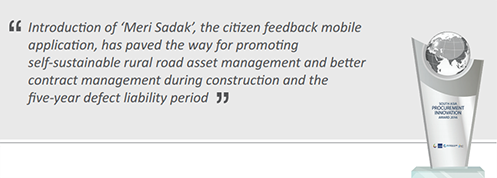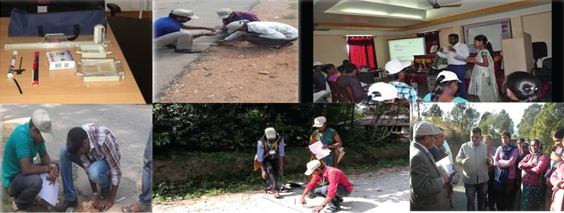Feature Stories
- How Bangladesh bridged the gap between amateur and professional in government procurement
- Rated Criteria: Promoting Value in World Bank Procurement
- Public Procurement Transformation in Bangladesh
- Achievement of Value for Money and Enhancement of Efficiency, Economy and Transparency in Procurement - Document Archive System
Archives
- End-to-End Procurement Planning and Maintenance System Integrated with Project MIS
- Application of Construction Milestones in Rural Road Contracts of Nepal
- Gross National Happiness Model for Pursuing Sustainable Public Procurement
- Government procurement is the basis of wide opportunities for enterprise development
- The Challenges of Procurement Training in a Fragile Country: the Afghanistan Experience
- When and How to Open Contracts: Transparency and Engagement through World Bank Projects
- Innovations and Best Practices in Procurement Processes of Disaster Recovery Projects
- World Bank Experts Discuss Global Procurement Trends and Armenia's e-GP system with the National Assembly
- Technology driving transparent and accountable public procurement reform in Bangladesh
- Prototype for Implementation of Framework Agreement via Blockchain
- Construction Project Planning and Management Capacity Building in India: A Wholistic Approach to Boost Infrastructure Development
- Zimbabwe: Public Procurement reform to catalyze greater transparency and development
- 15th Procurement, Integrity, Management and Openness (PRIMO) Forum
- e-Procurement World Map
- Preventing and controlling corruption: A modern approach to Procurement
- 6th South Asia Public Procurement Conference held in Thimphu, Bhutan
- South Asia Procurement Innovation Awards 2018 Announced
- Procurement iNET completes 5 years and new CPPP Fastest 100% Challenge Launched
- Risky Business: Does Debarring Poor Performers Mitigate Future Performance Risk?
- Global Procurement Summit 2019, New Delhi, India
- World Bank India launches Survey for International Civil Works Contractors
- World Bank launches new Complaints Module in Systematic Tracking of Exchanges in Procurement (STEP) System
- New Open Contracting Data Standard for e-Procurement Systems Launched
- Bangladesh's success in public procurement: Sustained reform really pays off
- The five drivers for improving public sector performance: Lessons from the new World Bank Global Report
- South Asia Public Procurement Innovation Awards 2018
- Conversation with Khaled Elarbi, President, High Authority for Public Procurement (HAICOP), Tunisia on the Digitalization of Public Procurement
- Breaking the glass ceiling in Africa: Rwanda E-Government Procurement System
- How government e-marketplace is revolutionizing procurement in India
- Ensuring Value for Money in Infrastructure Projects - The Botswana way
- Blockchain Lessons for Procurement
- Botswana’s Benevolent Move to Enhance its Procurement Profession
- Achieving Better Value for Money Using e-Auction for Procurement of Goods by Public Sector - A Success Case from DPDC
- Guide to Project Management and Contract Management (GPMCM) – New Approach to Improve Efficiency and Effectiveness of Procurement Outcomes
- Regional Winners of SAPIA 2017 participate in 8th International Public Procurement Conference (IPPC 8) Arusha, Tanzania
- The Future of Public Procurement in the Era of Digitalization
- World Bank Operations Procurement Helping Turkey to Procure a US$2 Billion Gas Storage Facility
- Unlocking Energy Efficiency Market in India - Through Innovative Procurement Business Model
- Getting value for money: Creating an automated market place for farmers in Pakistan
- Towards a Single Market for Public Procurement in Caribbean Small States
- Web-Based Online Evaluation Tool (e-Tool) for Procurement of Works by Royal Government of Bhutan
- Strengthening Health Sector Procurement System Offer Hopes for Universal Health Coverage in Nepal
- Morocco makes Strides in Modernizing its Public Procurement System— Operationalization of the Procurement Regulatory Body
- Innovations in Procurement Process and Selection that Lead to Improved Outcomes – Tenderers’ Database Management System
- Looking Back and Forward: The World Bank’s Procurement Framework
- Independent Monitoring and Evaluation of Contracted Health Services Leads to Improved Outcomes in Rural Areas of Afghanistan
- Fifth South Asia Region Public Procurement Conference brings focus on Procurement in Public Service Delivery
- 12 Procurement Innovations from South Asian Countries Celebrated
- Social Media is Improving Procurement in Lao PDR
- ASEAN meeting explores ways of professionalizing public procurement to meet development challenges
- Second International Training Program on the World Bank’s New Procurement Framework
- South Asia Procurement Innovations Award 2017 launched with Bigger and Better Prizes
- How to bid, finding opportunities, what makes a successful bid
- Pushing boundaries in procurement framework implementation
- Experience of Developing PPSD for the Assam Agribusiness and Rural Transformation Project (APART), India
- An Electronic Approach: Streamlining Georgia's Procurement
- South Asia Heads of Procurement Knowledge Exchange Program to U.S. Government Procurement Systems started
- 13th Procurement, Integrity, Management and Openness (PRIMO) Forum - a Documentary
- Bangladesh to strengthen public procurement with World Bank supported Project
- Establishment of Technology-Based Health Procurement and Supply Chain Management System, and Capacity Development in Tamil Nadu Medical Services Corporation
- Towards a Single Market for Public Procurement in Caribbean Small States
- Redefining Procurement as an Innovative and Collaborative Centre of Excellence for Best-in-Class Sourcing Solution
- India’s PowerGrid Endorsed for Alternative Procurement Arrangements by the World Bank
- Achieving Value for Money in Indonesia’s Geothermal Project
- Citizen Monitoring of Rural Roads Under Pradhan Mantri Gram Sadak Yojana (PMGSY), India
- Establishment of Grant and Service Contract Management Unit (GCMU) to Manage Contracting Out of Health Services in Afghanistan
- Procurement for Regional Development–Public Policy Initiative in Sri Lanka
- PPAF Community-Driven Development (CDD) Procurement Model, Pakistan
- Making Successful Procurement of IT Systems - An Experience from Vietnam
- Procurement Observatories continue to deliver in India
- Implementation of National e-GP System in Nepal
- Government e-Marketplace (GeM), India
- Africa High Level Public Procurement and Electronic Government Procurement Forums
- Development of Procurement Cadre as Part of Holistic Procurement Reforms in Bhutan
- Modernizing Public Procurement in Zimbabwe, one Step at a Time
- Citizen Engagement During Public Procurement Implementation in Bangladesh
- Winter 2017 Virtual Procurement, Integrity, Management, and Openness (PRIMO) Forum on Sanctions and Debarment Systems
- Close and Personalized Procurement Monitoring, Leading to Procurement Efficiency in Irrigation Sector in Fragile and Challenging Environments of Afghanistan
- Procurement Framework 2016 offers wider choices to ‘Go to Market’ based on PPSD
- Procurement Framework 2016 - Benefits, Status of Roll-out and M&E Arrangements
- PPSD offers Fit for Purpose Procurement Solutions
- Global Procurement Summit
- Fourth South Asia Region Public Procurement Conference
- The World Bank e-Procurement Tools
- South Asia Procurement Innovations Awards, 2016
- Learning Videos launched on STEP, online tracking tool on procurement for World Bank Projects
- Open e-Learning is Building a Cadre of Procurement Experts
- South Asia Region Public Procurement Conference, 2017
- Online Certificate Program in Public Procurement in Arabic Launched in Egypt
- First Procurement Knowledge Exchange Forum among ASEAN Countries
- Nobel Prize in Economics for contribution to Theory of Contract
- The Africa Region Harnesses Integrated e-Government Procurement (e-GP) Systems in Pursuit of Transparency and Integrity
- Procurement Reform for Humanitarian and Development Challenges in Kurdistan Region of Iraq (KRI)
- Successful Procurement is not just a set of Activities, it is a Strategy
- Afghanistan - Trends and Recent Developments in Governance
- PPSD is an Opportunity for clients and staff for Improved Procurement Management
- Procurement Reform Advances in the MENA Region
- Data Analysis and Collaborative Work in Action for Expedited Disbursements in Africa
- Ensuring Good Governance in Procurement in Sri Lanka
- New Procurement System to Improve Development Impact and Transparency in South Asia
- World Bank, USTDA Formalize Procurement Partnership
- How the New Procurement Framework Will Benefit 45.6 Million People in India
- Procuring the Future
- Reasons to Bid, Finding Business Opportunities
- New World Bank Procurement Framework Promotes Strengthened National Procurement Systems
- The readiness for Procurement Framework 2016
- 6 Things to know about New Procurement Framework
Citizen Monitoring of Rural Roads Under Pradhan Mantri Gram Sadak Yojana (PMGSY), India


{This article is an abridged version of the submission on “Citizen Monitoring of Rural Roads Under Pradhan Mantri Gram Sadak Yojana (PMGSY)” made by Mr. Rajesh Bhushan, Joint Secretary, Ministry of Rural Development, and Director General, NRRDA, for the South Asia Procurement Innovation Awards.}
Summary
The national rural roads development program of Government of India, “Pradhan Mantri Gram Sadak Yojana (PMGSY)”, launched in 2000, aims to provide road connectivity to 167,000 unconnected habitations in India. About 65% of the targeted 740,000 km roads, either new or under upgradation, have already been achieved. To ensure the program’s effectiveness, with citizen / user involvement in service planning and delivery, NRRDA, the national authority under Ministry of Rural Development, has also implemented a pilot Citizen Engagement program in 7 Indian States, defining the responsive role of citizen / user in PMGSY, from construction to maintenance of the rural roads constructed.
The pilot program involves identifying volunteers and their capacity building, developing a citizen-friendly toolkit to test various basic parameters of roads, IEC leaflets on awareness, and the role of citizen in monitoring and training modules. “Meri Sadak”, a mobile app launched to enable users to give their feedback regarding the pace of works, quality of works etc. using photographs and simple data entry, has had more than 500,000 downloads in 3 years. The inclusion of citizens in the PMGSY has paved the way for promoting self-sustainable rural road asset management, better contract management, and better service from contractors during the five-year defect liability period.
Background
Government of India launched the Pradhan Mantri Gram Sadak Yojana (PMGSY – Prime Minister’s Rural Roads Scheme) in 2000 to provide connectivity to Unconnected Habitations, as part of a poverty reduction strategy. According to the latest figures from a survey to identify the Core Network as part of the PMGSY program, about 167,000 Unconnected Habitations are eligible for coverage under the program. This involves construction of about 371,000 km of roads for New Connectivity and 368,000 km under upgradation. So far, 493,300 km of road works have been completed under both the categories. The PMGSY Program is implemented under the aegis of National Rural Roads Development Authority (NRRDA), Ministry of Rural Development, Government of India.
PRIs or Panchayat Raj Institutions and the local community are involved in identification of the networks to be constructed and upgraded. This facilitates involvement of users, citizen community, and all stakeholders in Government programs at the lowest level and makes PMGSY a sustained initiative across sectors. The emphasis of this citizen engagement is to bring in an aspect of ownership among local communities. Using the “Meri Sadak” mobile app, users of PMGSY roads can also contact the Nodal Departments in State Governments / NRRDA and give their feedback on the pace and quality of road works. According to Google Play Store, total downloads of “Meri Sadak” Mobile Application crossed 500,000 by December 2016. In addition, the overall increase in reviews rose from 718 to 7,508 in its three-year period, demonstrating the success of NRRDA’s efforts.

The pilot program faced many challenges during design and development due to the diversity in target rural population across the country:
- The most significant challenge addressed was establishment of a unified process / methodology of responsive involvement of citizens in PMGSY across the country.
- Another major challenge in defining a responsive citizen engagement process in PMGSY was the need to create awareness among citizens on their role in construction and maintenance of rural roads, and capacity building of identified volunteers on technical aspects in a much simpler way.
- Addressing the issue of reaching out to ordinary citizens with technology was also a significant challenge.
- Willingness of the political system is one significant concern, which draws limitations in implementation of various programs.
- Finally, women’s participation is one serious issue the program addressed, particularly the anticipation that women need to travel to different places.

Impact Generated
Inclusion of citizens in the PMGSY has paved the way for promoting selfsustainable rural road asset management. The major benefits from citizen engagement in terms of monetary and non-monetary terms are as follows:
- Though the Government nodal department is in-charge of the quality of construction and maintenance, impact on road condition and maintenance due to involvement of citizen monitoring led to in-time corrective measures, thus reducing depreciation of assets.
- Constant monitoring and persuasion to maintain these roads keeps them in a serviceable condition during all seasons.
- This led to empowerment of citizens from the grass-root level. With requisite technical knowledge, citizens are now able to also address technical issues. It has empowered women and ordinary citizens in monitoring the rural roads of PMGSY and similar projects in their locality.
- The engagement led to huge sustained increase in connectivity to markets, healthcare and education centres, and local area headquarters.
- Vigil of the community ensures adept monitoring of rural roads in their region.

The innovativeness of the solution was in developing, testing, standardizing, and piloting in two phases over 3 years (a) Simple citizen-friendly toolkit to capture and analyze data during construction and in maintenance. (b) A methodology for selecting Citizen Volunteers. (c) Data sheets for reporting. (d) Comprehensive training module including audio-visual and hands-on components in the module, considering the socio-economic-educational background of volunteers. (e) Developing master trainers on this.
The “Meri Sadak” mobile application developed is so simple and hassle-free that rural citizens have been able to embrace this technology and provide feedback on condition of roads. Inclusion of ICT has made it effortless to establish a healthy information cycle, from citizens to authorities and vice versa.
The tools developed and practices enabled data collection and reporting through a simplest process, which can be easily undertaken by an ordinary citizen. Making citizen as an asset in the system of PMGSY, which brings in benefits across sectors in rural development, was another innovation that directly contributed to more effective Social Audit processes in many other grassroot-level programs. Above all, this has efficiently and effectively brought in transparency and accountability into the system of rural roads.

Scalability and Sustainability
This process of citizen engagement can be replicated in all similar rural roads’ projects. “Meri Sadak”, the mobile application, is a state-of-the-art Citizen Feedback system that can be taken up as a redressal system for infrastructure. Capacity building by the program at grassroot level organizations, like Panchayati Raj Institutions (PRI) and Women Self Help Groups across the country, has built a critical mass of empowered stakeholders for any developmental efforts of the Government. Since the Indian sub-continent has a varied socio-economic status across geography, this system of citizen engagement can be easily adopted by developing countries in their programs. The ability of the program to instill ownership of roads within the community ensures sustainability of this monitoring system.


Ensuring effective contract management of rural assets by involving and empowering community is the most significant lesson from PMGSY experience. Citizen engagement in monitoring of these roads has led to a more systematic maintenance of roads as well as quality assurance during construction and maintenance of these roads. The five-year Defect Liability Period (DLP) under the contract makes the contractor responsible for maintaining the constructed road in a serviceable condition for 5 years post construction. However, it has been found that contractors were not responsible enough in maintaining these roads.
Participation of women was found to increase when their involvement was sought for assets in their proximity. As training of volunteers through Master Trainers took place in the respective village itself, there was increased women participation. This ensured that the volunteer group had a mix of both genders.
Citizen engagement in monitoring was found more effective when technology was used in the simplest way for data collection and analysis. Access to technical data on Online Monitoring Management and Accounting System (OMMAS) regarding the respective road of their village made it easier to monitor the roads during construction. Use of “Meri Sadak” mobile application to upload pictures easily as evidence when reporting has made the application a real-time monitoring tool.
